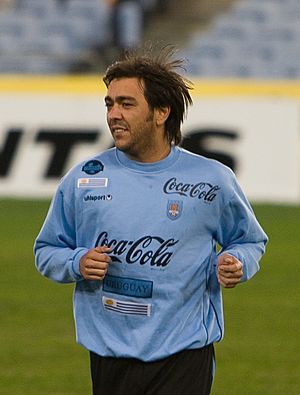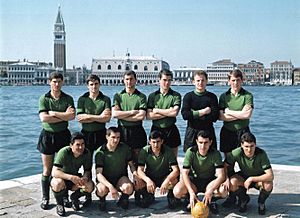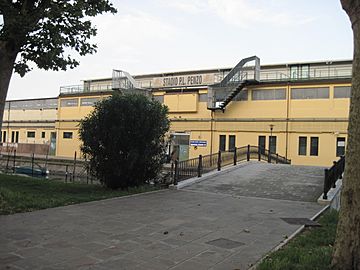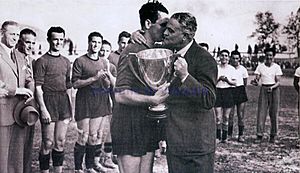Venezia FC facts for kids
 |
||||
| Full name | Venezia Football Club S.r.l. | |||
|---|---|---|---|---|
| Nickname(s) | I Leoni Alati (The Winged Lions) I Lagunari (The Lagoonal Ones) Gli Arancioneroverdi (The Orange-Black-Greens) |
|||
| Founded | 14 December 1907, (as Venezia Foot Ball Club) 2005, refounded as (Società Sportiva Calcio Venezia) 2009, refounded as (Foot Ball Club Unione Venezia) 2015, refounded as (Venezia Football Club) |
|||
| Ground | Pier Luigi Penzo | |||
| Capacity | 12,048 | |||
| Owner | VFC Newco 2020 LLC | |||
| Chairman | Duncan L. Niederauer | |||
| Head coach | Giovanni Stroppa | |||
| League | Serie B | |||
| 2018–19 | Serie B, 15th of 19 | |||
|
||||
Venezia Football Club is a professional football team from Venice, Italy. They play in Italy's second-highest football league.
The club was first started as Venezia Foot Ball Club in 1907. For most of its history, the team has played in Italy's top two football divisions.
Venezia's biggest win was the Coppa Italia (Italian Cup) in the 1940–41 season. The next year, they achieved their best-ever finish in Serie A, coming in third place.
Contents
- Venezia Football Club History
- Team Colors, Badge, and Nicknames
- Stadium
- Honors and Trophies
- Where Venezia Has Played in the Leagues
- Player Records
- Current Players
- Club Officials
- See also
Venezia Football Club History
How the Club Started
Venezia Foot Ball Club began on December 14, 1907. About 20 football fans in Venice joined together. They combined the football parts of two local sports clubs. The first matches were played in the pine forest of Sant'Elena island.
Venezia's first game was on December 22, 1907, against Vicenza, and it ended in a 1–1 draw. The team played against other clubs from the Veneto region. They also played against crews from ships visiting Venice's port.
Venezia first played in Italy's top league in 1909. In the 1911–12 season, Venezia reached the national final. They lost to Pro Vercelli.
On September 7, 1913, the Campo Sportivo Comunale di Sant’Elena stadium opened. This stadium was later named Stadio Pier Luigi Penzo. It had a covered stand for over 500 fans.
Years Between Wars (1919-1939)
Becoming AC Venezia
In April 1919, Venezia F.B.C. joined with another local club, Aurora F.B.C. They changed the club's name to Associazione Calcio Venezia. The government even helped the club with money.
In the 1921–22 season, Venezia moved down to a lower league. They returned to the second division in 1926–27. In 1927–28, Venezia finished second in their group. They were then allowed to join the top league, the Divisione Nazionale.
In the 1928–29 season, Venezia finished 11th and moved down to Serie B. This league started in the 1929–30 season.
Briefly SS Serenissima
In 1930, Venezia changed its name to Società Sportiva Serenissima. The club also changed its colors to red. The Lion of Saint Mark symbol was added to the jerseys.
In May 1931, the stadium was named after Pier Luigi Penzo. He was a pilot from World War I.
After five seasons in Serie B, S.S. Serenissima finished last in 1933–34. They were supposed to be relegated. However, the league expanded, so they stayed in Serie B.
Back to AC Venezia and Promotion
On August 1, 1934, the club went back to its old name, Associazione Calcio Venezia. They also returned to their traditional black and green colors.
In the 1934–35 Serie B season, Venezia was relegated to Serie C. But they quickly bounced back. They won Serie C in the 1935–36 season and moved straight back to Serie B.
Venezia also did well in the 1935–36 Coppa Italia. They reached the Round of 32. The team had a strong defense, known as the "iron median."
In 1937, Arnaldo Bennati became the club president. Venezia started to get better. In the 1938–39 Serie B season, Venezia finished second. This earned them promotion to Serie A. They won a dramatic game against Atalanta 1–0 on the last day. Francesco Pernigo scored the winning goal. He is still Venezia's top scorer in Serie A.
Because Venezia was going to Serie A, their stadium, Stadio Pier Luigi Penzo, was made bigger. Its capacity increased from 10,000 to 22,000 seats.
The Golden Era (1939-1943)
When Venezia returned to Serie A, they made their team stronger. Important players like Valentino Mazzola joined. In the 1939–40 Serie A season, Venezia finished 10th. They even beat the champions, Ambrosiana Inter.
In 1940, Giovanni Battista Rebuffo became the manager. Ezio Loik joined the team from A.C. Milan. Loik and Mazzola became a famous duo for Venezia. In the 1940–41 season, Venezia won the 1940–41 Coppa Italia. This was the club's first major trophy. They beat A.S. Roma 1–0 in the final.
The next year, Venezia almost won the Serie A title. In the 1941–42 Serie A season, Loik and Mazzola played amazingly. Pernigo scored 12 goals. Venezia finished third, which is still their best-ever Serie A result. They also reached the Coppa Italia semifinals.
In 1942, Venezia sold Loik and Mazzola to Torino. This was for a very large amount of money at the time. Venezia struggled in the 1942–43 Serie A season. They had to win a special game to stay in Serie A. However, they reached their second Coppa Italia final in three years. They lost to Torino, with Mazzola scoring against his old team.
Football competitions in Italy stopped after the 1942–43 season due to World War II.
After the War (1945-1968)
After World War II, the club went back to being Associazione Calcio Venezia.
In the 1946–47 season, Venezia was relegated to Serie B. Arnaldo Bennati also left as president. The club then went through a difficult time.
In the 1948–49 season, Venezia finished second in Serie B. This earned them promotion back to Serie A.
However, Venezia had money problems. They had to sell their top scorer, Adriano Zecca. In the 1949–50 Serie A season, they finished last and were relegated again.
Venezia spent four seasons in Serie C. They earned promotion back to Serie B in the 1956–57 season.
In the 1958–59 Coppa Italia, Venezia had a great run. They reached the semifinals, beating Roma and Torino. They lost to Inter Milan.
In the 1960–61 Serie B season, Venezia won the league. They returned to Serie A after 11 years. The team celebrated with a parade of gondolas on the Grand Canal.
In the 1961–62 Serie A season, Venezia had a good year. They beat Juventus and A.C. Milan. They finished 12th in the league.
But in the 1962–63 Serie A season, Venezia finished 17th and was relegated to Serie B again.
After three seasons in Serie B, Venezia was promoted to Serie A once more. This was after winning the 1965–66 Serie B season. But in the 1966–67 Serie A season, they were immediately relegated back to Serie B. They would not return to the top league for over 30 years. In the 1967–68 Serie B season, Venezia was relegated to Serie C.
Years in Lower Leagues (1968-2005)
After 1968, Venezia spent many years in lower leagues like Serie C, Serie C1, Serie C2, and Serie D.
Maurizio Zamparini Takes Over
In 1986, businessman Maurizio Zamparini bought Venezia. He led the club for the next 16 seasons.
In 1987, Zamparini merged Venezia with another local club, A.C. Mestre. The club was temporarily called Calcio VeneziaMestre. In 1989, it became Associazione Calcio Venezia again. The club's colors changed to orange, black, and green. The team's home games moved to Mestre.
In the 1987–88 season, Venezia was promoted from Serie C2 to Serie C1.
Return to Serie B
In the 1990–91 season, Venezia was promoted back to Serie B. This was after 23 years away. They won a playoff game against Como.
Because their stadium in Mestre was too small for Serie B, Venezia moved back to Stadio Pier Luigi Penzo in Venice. The stadium was renovated and made bigger.
Venezia played in Serie B for the next seven seasons.
Return to Serie A
In the 1997–98 Serie B season, Venezia finished second. They were promoted back to Serie A after 31 years.
For the 1998–99 Serie A season, the team got stronger. Players like Filippo Maniero and Massimo Taibi joined. Venezia was at the bottom of the league at first. But then, young player Álvaro Recoba joined on loan. Maniero and Recoba scored many goals together. Venezia moved out of the relegation zone. They finished 11th, staying in Serie A.
In the 1999–2000 Serie A season, Venezia struggled without Recoba. They went through three different coaches. They reached the Coppa Italia semifinals but were relegated to Serie B.
For the 2000–01 Serie B season, Venezia hired manager Cesare Prandelli. He led them straight back to Serie A. But Prandelli left early in the 2001–02 Serie A season. Venezia finished last and was relegated again.
Zamparini Leaves and Bankruptcy
On July 21, 2002, Zamparini left Venezia to take over Palermo. The next day, 12 players and the manager were moved from Venezia to Palermo. This was called the "theft of Pergine."
Venezia struggled in Serie B. At the end of the 2004–05 Serie B season, Venezia was relegated and declared bankrupt.
Rebuilding the Club (2005-2015)
Società Sportiva Calcio Venezia
In the summer of 2005, the club was restarted as Società Sportiva Calcio Venezia. They were allowed to play in Serie C2. In the 2005–06 Serie C2 season, Venezia was promoted to Serie C1. They played there for three seasons. But by the end of the 2008–09 season, the club went bankrupt again.
Foot Ball Club Unione Venezia
In 2009, the city of Venice was almost without a football club. The mayor helped start a new club. On July 27, 2009, the club was restarted as Foot Ball Club Unione Venezia. They were allowed to play in Serie D. Venezia won Serie D in the 2011–12 season. They were promoted again in 2012–13. But after two seasons, they went bankrupt for the third time in 10 years.
Venezia FC Today (2015-Present)
Venezia FC is Born
In September 2015, a group of American investors bought the club. They restarted it as Venezia FC. In the 2015–16 season, Venezia was promoted from Serie D to Serie C.
Filippo Inzaghi's Time
In June 2016, Venezia hired Filippo Inzaghi as manager. He was a famous former player for the Italian national team.
In Inzaghi's first season (2016–17), Venezia was promoted to Serie B. They also won the Coppa Italia Serie C. They secured the Serie C title on April 19, 2017.
In the 2017–18 Serie B season, Venezia surprised everyone. They finished fifth and almost got promoted to Serie A. They won their first playoff game. But they lost to Palermo in the semifinals.
In June 2018, Inzaghi left Venezia.
New Ownership and Return to Serie A
After Inzaghi left, Venezia had three different coaches in the 2018–19 Serie B season. They finished 15th. They were almost relegated to Serie C. But Palermo was punished, which saved Venezia.
In February 2020, Duncan Niederauer, a former CEO of the New York Stock Exchange, became the club president. The 2019–20 Serie B season was stopped due to the COVID-19 pandemic. When it started again, Venezia played well. They stayed in Serie B, finishing 11th.
In August 2020, Venezia hired new staff. This included former players Mattia Collauto and Paolo Poggi. Paolo Zanetti became the manager.
In the 2020–21 Serie B season, Venezia finished fifth. They qualified for the promotion playoffs to Serie A. They beat Chievo Verona and Lecce. In the final, Venezia played against A.S. Cittadella. They won 1–0 away and drew 1–1 at home. This meant Venezia was promoted to Serie A after 19 years! This was a very fast rise from Serie D to Serie A in just five years.
Venezia celebrated their return to Serie A with a parade of historical boats and gondolas on the Grand Canal.
On August 9, 2021, the club bought American midfielder Gianluca Busio. This was a record transfer for them. Venezia's first game back in Serie A was a 2–0 loss to Napoli. However, their time in Serie A was short. They were relegated back to Serie B at the end of the season.
Serie B: 2022–2024
For the 2022–23 Serie B season, Ivan Javorčić became the new head coach. The team signed new players like Joel Pohjanpalo and Jesse Joronen. The season started slowly. Javorčić was fired in October 2022. Paolo Vanoli was hired as the new coach. The team improved and finished 8th. Pohjanpalo scored 19 goals. Venezia made it to the promotion playoffs but lost to Cagliari.
At the end of the 2023–24 season, Vanoli led Venezia to finish 3rd. Captain Pohjanpalo won the Golden Boot with 22 goals. In the promotion playoffs, Venezia beat Palermo and Cremonese. They were promoted back to Serie A after two seasons in Serie B.
Team Colors, Badge, and Nicknames
|
|
| Venezia's original kit |
Venezia's first colors were blue and red. Their shirts looked like Genoa's. But just one year after starting, the club changed to black and green.
Later, in 1987, when the club merged with A.C. Mestre, orange became one of Venezia's official colors. This gave them the nickname arancioneroverdi (orange-black-greens). Venezia's kit is very unique. The shirt, shorts, and socks are usually black with green and orange trim.
The club's symbol is a winged-lion. This is the official symbol of Venice. This symbol led to one of the club's popular nicknames: leoni alati (winged-lions).
The club's badge has changed many times. The most common one shows the golden winged lion with the green and orange club colors. Since Venice is on the Venetian Lagoon, the club is also called lagunari (Lagoonal ones).
Stadium
Venezia's home stadium is Stadio Pier Luigi Penzo. It first opened in 1913. It is named after World War I pilot Pier Luigi Penzo. Stadio Penzo is the second-oldest stadium in Italy.
The stadium is on Sant'Elena island. It is special because you can mostly get there by boat.
The most people who ever attended a game was 26,000. This was for a Serie A match in 1966 against A.C. Milan.
The stadium was first made of wood. It was upgraded with a concrete main stand in the 1920s. More improvements were made over the years.
On September 11, 1970, a tornado hit Venice. It badly damaged the stadium. Only part of it was rebuilt. The number of seats went down to just over 5,000.
When the club returned to Serie A in 1998, more temporary stands were added. This brought the capacity up to 13,400. However, it has since been reduced to the current capacity of 7,450.
Honors and Trophies
League Titles
- Serie B
- Winners: 1960–61, 1965–66
- Serie C/Serie C1
- Winners: 1935–36, 1955–56, 2016–17
- Serie C2
- Winners: 2005–06
- Serie D
- Winners: 1982–83, 2011–12, 2015–16
Cup Wins
- Coppa Italia
- Winners: 1940–41
- Coppa Italia Lega Pro
- Winners: 2016–17
Where Venezia Has Played in the Leagues
| Series | Years | Last | Promotions | Relegations |
|---|---|---|---|---|
| A | 14 | 2024–25 | — | |
| B | 38 | 2023–24 | ||
| C C2 |
23 10 |
2016–17 | ||
| 84 out of 91 years of professional football in Italy since 1929 | ||||
| D | 7 | 2015–16 | Never | |
Player Records
Most Games Played
- These are for official professional matches only.
Top Goal Scorers
- These are for official professional matches only.
Current Players
|
|
Players on Loan
|
|
Other Players Under Contract
|
Club Officials
See also
 In Spanish: Venezia Football Club para niños
In Spanish: Venezia Football Club para niños






